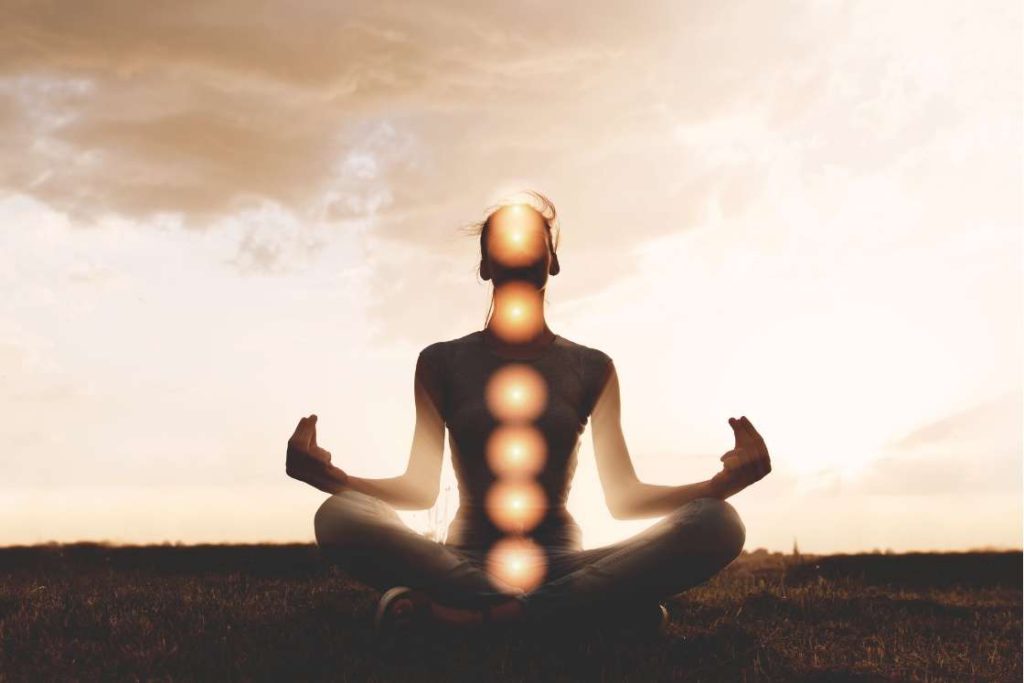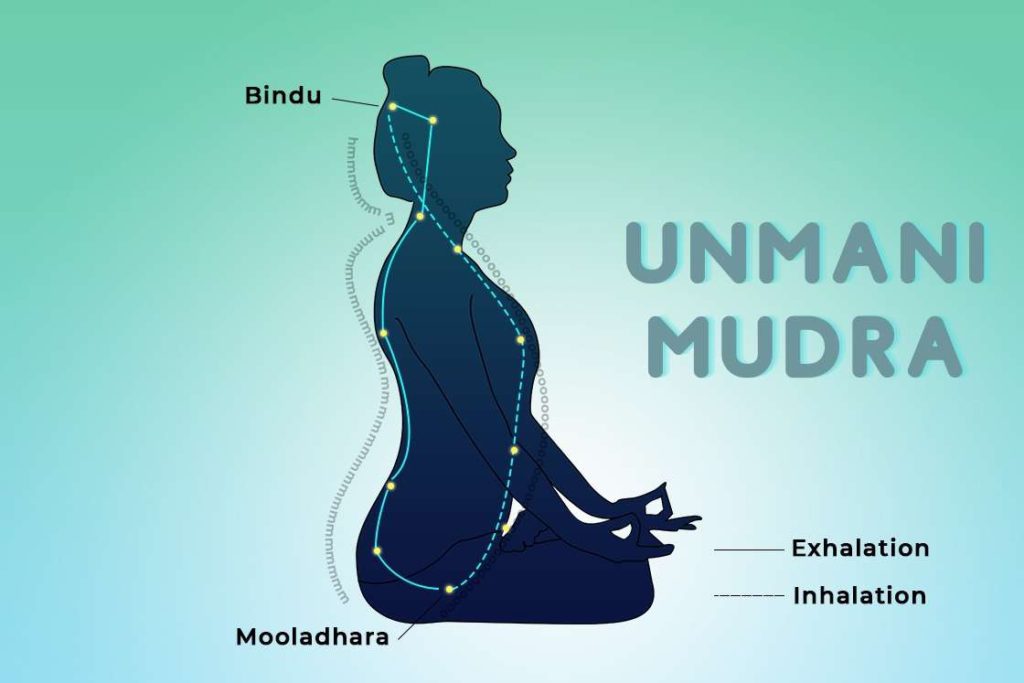
Unmani is a Sanskrit term translated as “no-mind” or “thoughtlessness”. This is defined as a transition state attained between dreaming and waking. It shows one of the states of samadhi (one of the limbs of Patanjali’s Yoga) known as Unmani Avastha.
Unmani Mudra is a perfect escape to transcend all the troubles, attachments, and connections. The thought patterns that arrives holding this mudra lies somewhere in between consciousness and unconsciousness. It is similar to a meditation technique and categorized as a Mana mudra (Head gesture).
As the practitioner reaches a thought-free mindless state in Unmani mudra, hence the name. It is also referred to as ‘mindlessness mudra’ or ‘attitude of mindlessness’.
The Technique

The technique of Unmani Mudra is defined in kriya yoga practices including Nada, Pawan, Shabda Sanchalana, Maha Mudra, and Maha Bheda mudra. Unmani mudra involves Awarohan (descending) psychic passage through which it enables the practitioner to sink awareness.
Practicing Unmani mudra involves opening the eyes wide open and drawing the awareness at the Bindu (back of the head). With gently descending the awareness from Ajna chkara towards the Muladhara chakra. With going down on chakras the eyes also tend to close.
Unmani mudra is all about drawing awareness to the inner self and leaving the external possessions aside. Hence, it is well described as a mental practice rather than a physical one.
This practice enriches the awareness function by dissipating the capacity of thinking and analyzing about materialistic desires.
Unmani mudra and its significance are described by Lord Krishna to Arjuna in Mahabharata. “Whenever a Siddha yogi performs a yogic posture, pranayama, or mudra, Unmani mudra is attained itself,” says Krishna.
There, Unmani mudra is defined as a blissful state of Rajayoga.
How to Do Unmani mudra
- Sit in any comfortable meditative pose.
- Open your eyes to the fullest without straining.
- Inhale slowly and deeply.
- Retain the breath inside and shift the focus to Bindu (Imagine a point at the back of the forehead).
- Exhale gradually along with descending the awareness from Bindu through the chakras in the spine. It follows the order Ajna, Vishuddha, Anahata, Manipura, Swadhisthana, and finally terminating at the Muladhara.
- With descending the awareness, gradually close your eyes, and shut them fully reaching the Muladhara.
- The awareness must be concentrated to look within whether the eyes are closed or opened.
- Allow yourself to go through this process spontaneously and effortlessly.
- Inhale again to begin the next round.
- Repeat the process for 11 rounds.
Contraindications
- Patients with glaucoma must avoid Unmani mudra.
- It must not be practiced in other vision problems like diabetic retinopathy.
- Do not try it if you’ve had recent eye surgery.
Duration of practice
- Practicing Unmani mudra is recommended in the early morning hours.
- It must be practiced for a duration of five to ten minutes.
- Always try this gesture on an empty stomach.
Unmani mudra variant
There is an easier variation to practice Unamni Mudra having slight modification as follows:
- Select a point in front of you and fix your gaze to that point.
- Breathe gently and continue gazing towards the selected point.
- After a while, bring your upper and lower eyelids closer until the eyes are half-closed.
- Hold this position and try to concentrate only on your gaze.
- Continue it until you become lost and only aware of the fixed spot.
- This ultimately leads you to a state where you will stop seeing and realizing anything around and merge with the spot.
- It enables you to transcend the conscious state of mind.
What happens in Unmani mudra
Unmani mudra is all about fixing the attention on a point or idea. This empties the mind from all the thought processing for a while. It is the time when the divinity takes over.
This mudra takes the practitioner to a state where the mind is kept at rest. As the salt dissolves in water losing its identity, similarly, in unmani mudra, the identity of the mind doesn’t remain intact.
While holding Unmani mudra, the body is assumed as a hollow entity from within. This enables the practitioner to derive the pranic flow anywhere inside the body. It involves Bhru-Madhya Chakra in the Sushumna Nadi. The prana and mind components are fused completely in the eternal self above and beyond the eyebrow junction.
This is known as “Nishpanna Avasthha,” which refers to a state of fulfillment.
The advantage of Unmani mudra is the attainment of siddhis like reading others’ thoughts, psychic powers, and other yogic advancements. This mudra is a way of feeling emancipated and fulfilled.
Unmani Mudra Benefits
- Unmani mudra has relieving effects on psychological issues, viz. stress, anxiety, and agitation.
- It brings forth joy, focus, and inner glory.
- It soothes and calms the mind by leading the practitioner towards attaining samadhi.
- This mudra saturates the practitioner with sattva (goodness).
- It brings all the mental chatter, confusion, and analysis to a halt.
- Unmani mudra stimulates all the energy chakras and brings mental and physical harmony.
- It balances all three doshas and tissues of the body.
Conclusion
Unmani mudra is a gesture that enables the practitioner to reach the highest possible state of samadhi. It helps in having a never before experience and makes you a better version of yourself.
So, if in any case, you are finding ways to transform as a human being, spare some minutes from your daily schedule for Unmani mudra.




